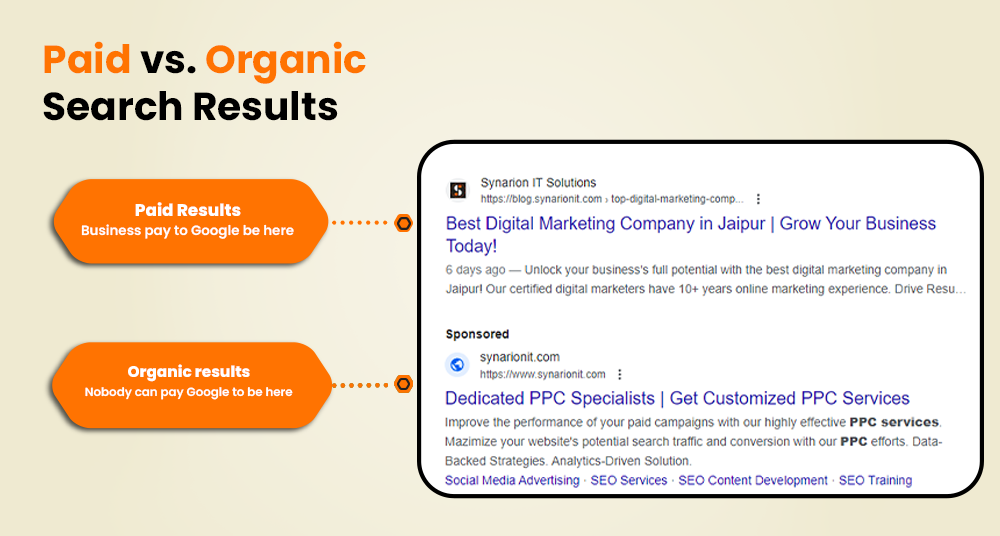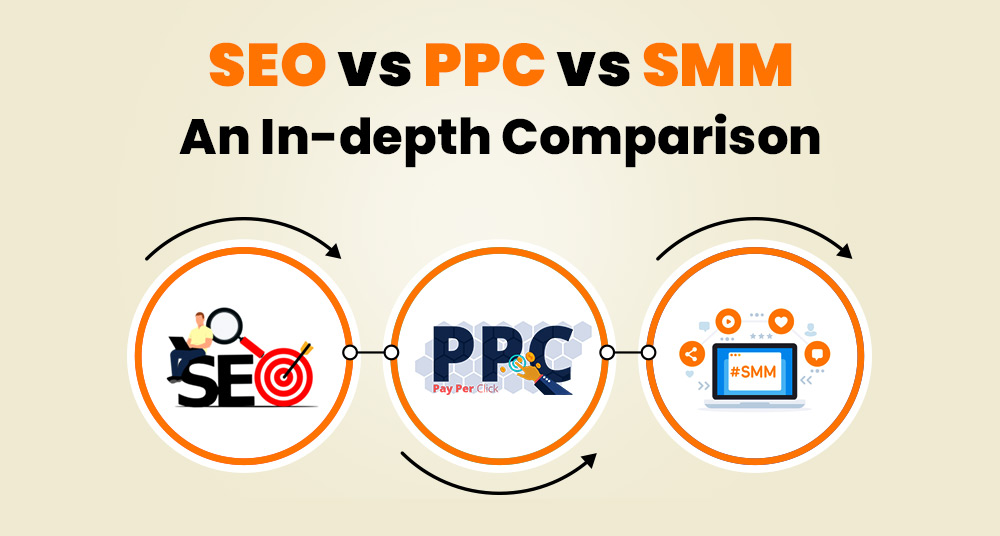Know How Paid Advertising Helps in SEO in The Competitive World?
In the busy world of the internet, businesses fight for exposure, connection, and sales. This makes digital marketing more difficult. This is a very competitive field, and SEO and Paid Advertising (PPC and SMM) rule it. Because they have their own benefits and problems, these tactics are important for digital marketing.
Digital marketers use SEO to make sure that the content and layout of a website show up higher in Google’s original search results. The goal is to get targeted visitors without having to pay for ads. You need to do keyword study, write content, optimize your website technically, and build backlinks. By getting long-term traffic, SEO boosts the trustworthiness and influence of a website.
Direct investments in advertising make Paid Advertising more visible and bring in more visitors. In PPC, companies pay every time someone clicks on their ad. By showing up right away in search results and on social media, it helps companies reach specific groups of people based on their traits, hobbies, and habits. SMM uses both free and paid social media material to get people interested in your business, raise knowledge of it, and boost traffic and sales. It helps companies get in touch with their customers directly by using the social and engaging features of the web.
Free organic traffic from SEO takes work and time to keep up with the results. People can see your PPC ads right away, but they can be pricey and only work for a short time. SMM makes people attached to a brand, but it needs constant content creation and community management.
Even though each has pros and cons, the best way for an online business to grow over time is to combine SEO, PPC, and SMM. Combining ways makes multimedia benefits and awareness even better. Combine the long-term benefits of SEO, the instant exposure of PPC, and the involvement power of SMM to increase brand awareness, attract a wide range of people, and increase sales.
What SEO is and what its goals are?

Google’s organic (non-paid) search engine ranks go up when you use SEO as part of your digital marketing plan. SEO helps a website get more visitors, rank higher in organic search results, and raise knowledge of its business. Search engines like Google, Bing, and Yahoo like the content, structure, and on-page information that are designed for them. Search engines use algorithms to rank material based on things like terms, how easy the site is to use, and the quality of the backlinks.
The site’s organic score and exposure tell users that they can trust it and that it answers their questions. People click on the first few results in SERPs, so having a high rank can bring more people to your website. Potential customers are more likely to believe organic search results because they are won through good content and smart optimization techniques. This sense of power and trustworthiness can be a big deal in competitive markets.
Why do you pay for marketing?
Webmasters get paid every time someone clicks on one of their ads (PPC). It’s a way to get people to visit your website without having to “earn” them naturally like SEO does. People can see pay-per-click (PPC) ads based on their age, gender, location, hobbies, and even the time of day on search engine results pages (like Google AdWords) or social media sites (like Facebook Ads). Pay-per-click (PPC) is a great way to turn attention into sales because it gets people to do something, like buy something or sign up for a program.
SMM uses websites and social media to get the word out about goods and services. SMM uses free ways to get people to follow it and interact with a community, but it also uses paid ads more and more to reach more people quickly. Social media ads can be made to fit the site and audience by looking at things like user behavior, hobbies, and more. SMM in paid Advertising uses interesting and relevant content to make brands more visible, get users involved, and increase traffic or sales. People are more likely to share, like, and react to social media ads than pay-per-click (PPC) ads because they push people to do these things.
An In-Depth Comparison Between SEO and PPC
| PPC | |
| Organic Position | Paid Position |
| Traffic over time | Immediate Traffic |
| Long term results | Get instant results |
| Ongoing process | One time setup |
| Algorithm Updates may impact traffic | No Impact of Algorithm Updates on Traffic |
| Improved Visibility | Increase Sales |
| With SEO you get traffic from all search engines (Google, Bing, Yahoo etc) | Get Platform specific Traffic |
| Adsence Approval Yes | Adsence Approval No |
| Free/lower cost | Only Paid |
Efficient use of money
SEO:
You have to spend money upfront on creating and optimizing content for SEO. However, it offers long-term benefits and steady flow at a lower ongoing cost. The money you put into the website at the beginning will pay off as it gets influenced and naturally ranks higher.
PPC:
With PPC, on the other hand, you pay directly for each click, which can add up quickly. It brings in traffic right away and could lead to sales, but the flow stops when the payment is made. It can get pricey to use the cost-per-click approach, especially for very competitive terms.
Timeline and Results
SEO:
SEO is a long-term plan, and it can take months for big changes to show up. Rankings and traffic grow naturally over time, so the process is slow. However changes to search engines’ algorithms can affect SEO efforts, so they need to be tweaked all the time to keep working.
PPC:
When you start a PPC campaign, you’ll get visitors and exposure right away. It skips over the slow process of SEO and gives you benefits right away. Also, changes to algorithms don’t have a direct effect on PPC ads. But they need constant funds to keep the traffic and results going.
Audience Targeting and Engagement
SEO:
SEO brings in people who are actively looking for information, goods, or services that are connected to yours. Because search terms are relevant, they tend to bring in people with a strong desire to use them. However, user engagement is passive, limited to clicking on search results and browsing website content.
PPC:
PPC allows advanced targeting options, including demographics, interests, and location. This lets companies send customized texts to specific groups of people. Moreover, PPC encourages active engagement through ad interactions, leading to higher conversion rates.
Sustainability and ROI
SEO:
SEO provides enduring value through brand authority and ongoing visibility. While the initial ROI may be slower, it tends to increase over time as the site attracts more organic traffic. With consistent effort, SEO can deliver sustainable results and a high return on investment.
PPC:
PPC offers a quick ROI by driving immediate sales or leads. However, its long-term ROI may not match SEO’s due to the need for continuous expenditure. PPC traffic and results dwindle without ongoing investment, making it less sustainable in the long run.
SEO vs. SMM: Understanding the Differences
| SEO | SMM |
| SEO primarily focuses on enhancing website visibility on the SERP. | SMM focuses on brand awareness by engaging users through social media platforms. |
| Audience integration in SEO is passive as user users come to your website by making queries on Search Engine. | In SMM users interact with brands by doing such activities like, comment, dm and share. |
| Performance in SEO is typically measured by keyword rank, impression, click, and CTR. | Performance in SMM is tracked by likes, comments, shares, and brand mentions. |
| Change your SEO strategies on behalf of algorithm updates. | SMM strategies may change how content is performing or engaging your targeted users. |
Goals and Strategies
SEO:
SEO primarily focuses on improving a website’s visibility in search engine results pages (SERPs) through organic means. Its goals are enhancing organic reach and engagement by optimizing website content, meta tags, and backlinks.
SMM:
SMM (Social Media Marketing) emphasizes building brand awareness and fostering engagement through social media platforms. Content creation and engagement strategies are central to SMM, aiming to resonate with the target audience and encourage interaction.
Audience Interaction
SEO:
Audience interaction in SEO is largely passive, as users discover websites through search engine queries. While users may engage with content by clicking on search results or browsing through pages, direct interaction opportunities are limited compared to social media platforms.
SMM:
SMM encourages active engagement and community building on social media platforms. Users can interact with brands through likes, comments, shares, and direct messages, facilitating two-way communication and relationship building.
Measurement and Analytics
SEO:
SEO metrics typically include keyword rankings, organic traffic, click-through rates (CTR), and conversion rates. These metrics provide insights into the effectiveness of SEO strategies and help identify areas for improvement.
SMM:
SMM analytics measure engagement metrics such as likes, shares, comments, and mentions across social media platforms. Additionally, metrics like reach, impressions, and click-through rates provide valuable insights into the performance of social media campaigns.
Adjusting strategies based on performance data:
SEO and SMM rely on data-driven insights to refine strategies and improve performance. SEO strategies may be adjusted based on changes in search engine algorithms or shifts in keyword rankings. Similarly, SMM strategies can be refined based on engagement metrics, audience demographics, and campaign performance data.
Integrating SEO and Paid Advertising for Business Growth
The Complementary Nature of SEO and PPC
How SEO and PPC can support each other for better visibility:
SEO and PPC work together synergistically to improve a business’s online visibility. While SEO focuses on organic search traffic, PPC offers immediate visibility through paid ads. By integrating both strategies, businesses can maximize their presence on search engine results pages (SERPs) and capture a broader audience.
Using PPC data to inform SEO strategies and vice versa:
PPC data provides valuable insights into keyword performance, ad copy effectiveness, and audience behavior. This data can inform SEO keyword research, content optimization, and targeting strategies. Similarly, SEO data such as keyword rankings and organic traffic trends can guide PPC campaign targeting and ad messaging.
Leveraging SMM with SEO and PPC
Enhancing brand presence and audience engagement through SMM:
SMM plays a crucial role in enhancing brand presence and fostering audience engagement. Businesses can strengthen their brand identity and build relationships with their audience by creating compelling content and engaging with followers on social media platforms.
The role of social signals in SEO:
Social signals, such as likes, shares, and comments on social media posts, are increasingly influencing SEO rankings. Engaging content that generates social interactions can improve a website’s authority and relevance, ultimately leading to better search engine visibility.
Challenges and Considerations
Budget Allocation
Understanding Business Goals and Priorities:
- Conduct thorough discussions with stakeholders to align marketing objectives with overall business goals.
- Prioritize objectives such as brand awareness, lead generation, or sales conversion based on business needs.
ROI Analysis and Budget Distribution:
- Conduct a comprehensive analysis of past campaigns to determine the ROI of each marketing channel.
- Allocate budget proportionally to channels that historically yield higher ROI, and consider the potential for growth in newer channels.
Performance Monitoring and Adjustment:
- Implement robust analytics systems to track each marketing channel’s key performance indicators (KPIs).
- Regularly review performance data and adjust budget allocations based on real-time insights to maximize efficiency and effectiveness.
Keeping Up with Changes
Monitoring Industry News and Updates:
- Establish a system for monitoring industry publications, blogs, and forums for the latest news and trends in digital marketing.
- Subscribe to newsletters and alerts from search engines and social media platforms to stay informed about algorithm updates.
Continuous Education and Development:
- Encourage team members to participate in conferences, webinars, and workshops to stay updated on best practices and emerging trends.
- Invest in online courses and certifications to deepen knowledge and expertise in SEO, PPC, and SMM.
Proactive Adaptation to Changes:
- Develop a culture of agility and innovation within the marketing team to respond quickly to changes in the digital landscape.
- Conduct regular brainstorming sessions to generate ideas for adapting strategies in response to algorithm updates or shifts in consumer behavior.
Skill Sets and Resources
Building a Multidisciplinary Team:
- Recruit team members with diverse skill sets and backgrounds in content creation, data analysis, and campaign management.
- Foster collaboration and cross-training among team members to leverage collective expertise across SEO, PPC, and SMM.
Investing in Training and Development:
- Provide opportunities for team members to attend training programs and workshops tailored to their specific roles and responsibilities.
- Offer mentorship and coaching programs to support team professional growth and skill development.
Utilizing Tools and Technologies:
- Research and invest in tools and software platforms that streamline processes and improve efficiency in managing SEO, PPC, and SMM campaigns.
- Implement automation tools for keyword research, ad optimization, and social media scheduling to save time and resources.
Conclusion
Integrating SEO, PPC, and SMM offers synergistic benefits that enhance online visibility, engagement, and business growth. By combining these strategies, businesses can achieve greater reach, target diverse audience segments, and capitalize on various customer journey stages. A holistic approach to online marketing ensures a cohesive brand presence across multiple channels, maximizing the impact of marketing efforts and fostering long-term success. Therefore, businesses must adopt an integrated marketing strategy that leverages the strengths of SEO, PPC, and SMM to drive meaningful results. Let us embark on this journey together, embracing the power of synergy and innovation in the digital landscape to propel our businesses to new heights of success.






What do you think?
It is nice to know your opinion. Leave a comment.